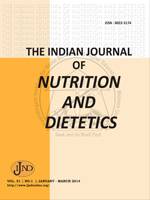Nutritional Status of Children (2-5 Years) in Isiala Ngwa North L.G.A, Abia State, Nigeria
Subscribe/Renew Journal
The study assessed the nutritional status of children aged 2-5 years in Isiala Ngwa North L.G.A, Abia State. One hundred and fifty pre-school children were randomly selected for the survey of which 78 were males and 72 females. Structured and validated questionnaires were used in data collection. Data collection included personal information of the child, family information, food habits/dietary pattern of the children, anthropometric measurements of the preschool children and food frequency questionnaire. Data obtained from the survey were analysed using descriptive statistics - frequency, percentages and correlation. The statistical software SPSS version 18 was used for analysis, cross tabulation and chi square analysis were used to examine the relationship between the variables. Significance was accepted at P < 0.05. The indicators of nutritional status were calculated using WHO Anthro. The results showed that 10% of the respondents were wasted, 36% stunted and about 20.3% were underweight. Malnutrition was more prevalent among females than in males. The foods frequently consumed by the respondents were carbohydrates, for example, garri, rice and bread. Protein rich foods sometimes complemented their diets consciously or unconsciously with foods like fish, crayfish, beans and milk being consumed by the respondents. Socioeconomic and demographic variables like type of cooking fuel used, type of house, single parenthood, monthly income, source of drinking water and toilet facility had a significant association (P<0.05) on the nutritional status of the respondents. The nutritional status of preschool children in this study was poor. Adequate nutrition is essential to children's growth and development.
Keywords
Nutritional Status, Children 2-5 Years, Child Nutrition, Malnutrition, Stunted, Wasted, Underweight.
User
Information
- Shubhangini, A.J. Nutrition and Dietetics, 2nd Edition. Tata, New Delhi: McGraw Hill publishing Company Limited. 2004.
- Burgress, A. and Campbel, H. Promoting good nutrition – child health dialogue. West African J. Nurs., 1997, 4, 1-7.
- Nnam, N.M. and Njoku, I.E. Production and evaluation of nutrient and sensory properties of juice made from citrus fruit. Nigerian J. Nutr. Sci., 2005, 26, 62-65.
- Chukwudire, F.M., Ihekoronye, C.N., Nnadede, L.U., Ijioma, B.C. and Okeke, E.N. Determining the nutritional status of pre-school children (2-5years) in Isiala-ngwa North local government area of Abia State using anthropometric measurement. CCSD: Int. J. Vocational Studies. Ghana; Kandid Gold Accra. 2010.
- UNICEF. The State of the World’s Children. United Nations Children’s Fund, New York. 2015.
- Ajaka, A.U. Ill health: causes and preventive measures. West African J. Nurs., 2005, 16, 64-69.
- Amosu, A.M., Degun, A.M., Atuloma, N.O.S. and Olanrewju, M.F. A study on nutritional status of under-5 children of low-income earners in a South-Western Nigerian Community. Nigeria, Maxwell Scientific Organization. 2011.
- World Health Organization. Nutrition for Health and Development: A global agenda for combating malnutrition. Geneva. 2000.
- Nigeria Demographic and Health Survey. National Population Commission Federal Republic of Nigeria Abuja, Nigeria. ICF International Rockville, Maryland, USA. 2013.
- World Health Organization. WHO Child growth standards based on length, height and age. WHO Multicentre Growth Reference Study Group: ACTA 95 (Suppl. 450), 2007, 76-85.
- Maziya-Dixon, B., Akinyele, I.O., Oguntona, E.B., Nokoe, S., Sanusi, R.A. and Harris, E. Nigerian food consumption and nutrition survey. International Institute of tropical Agriculture. John Wibbey and Co. Ltd. 2003.

Abstract Views: 271

PDF Views: 0




